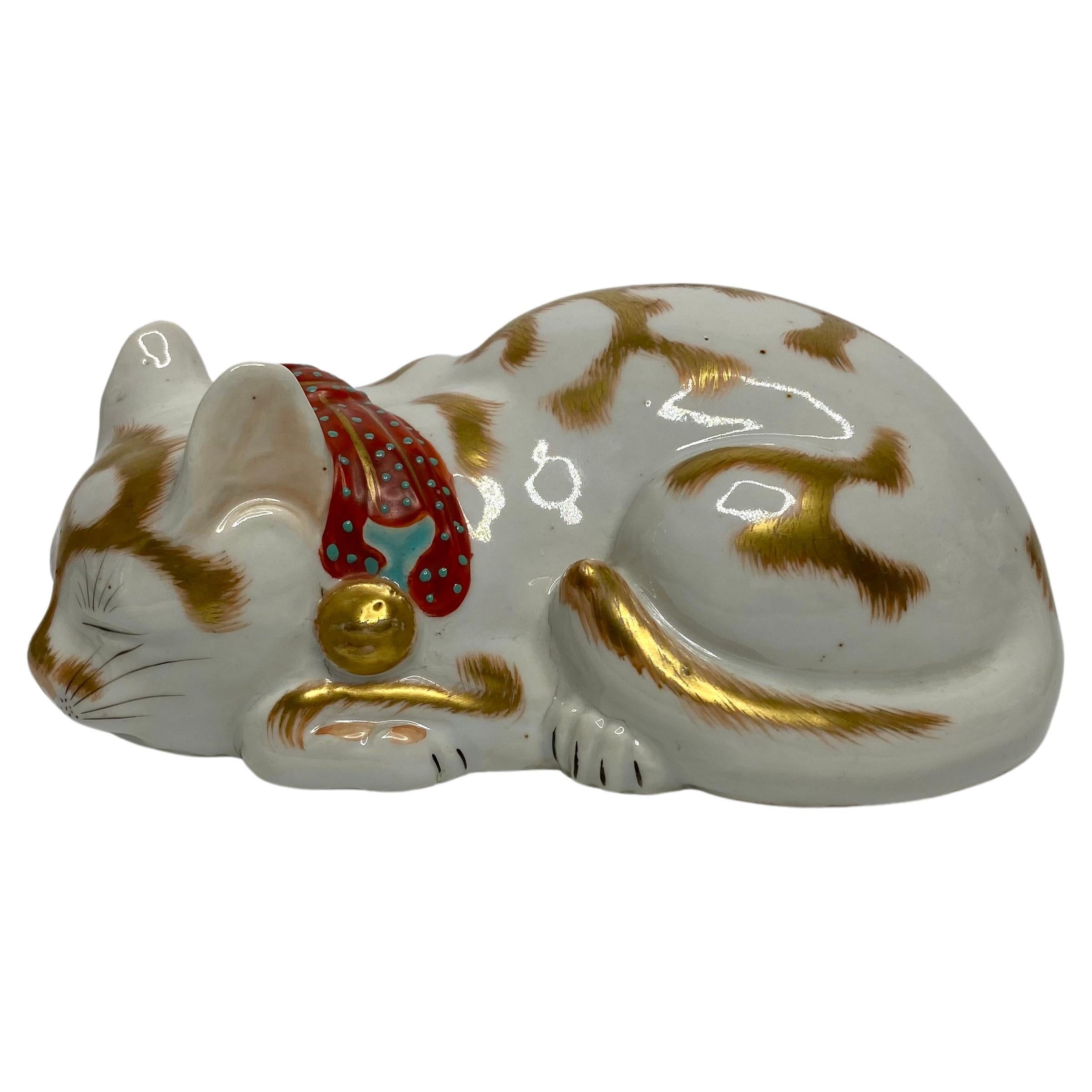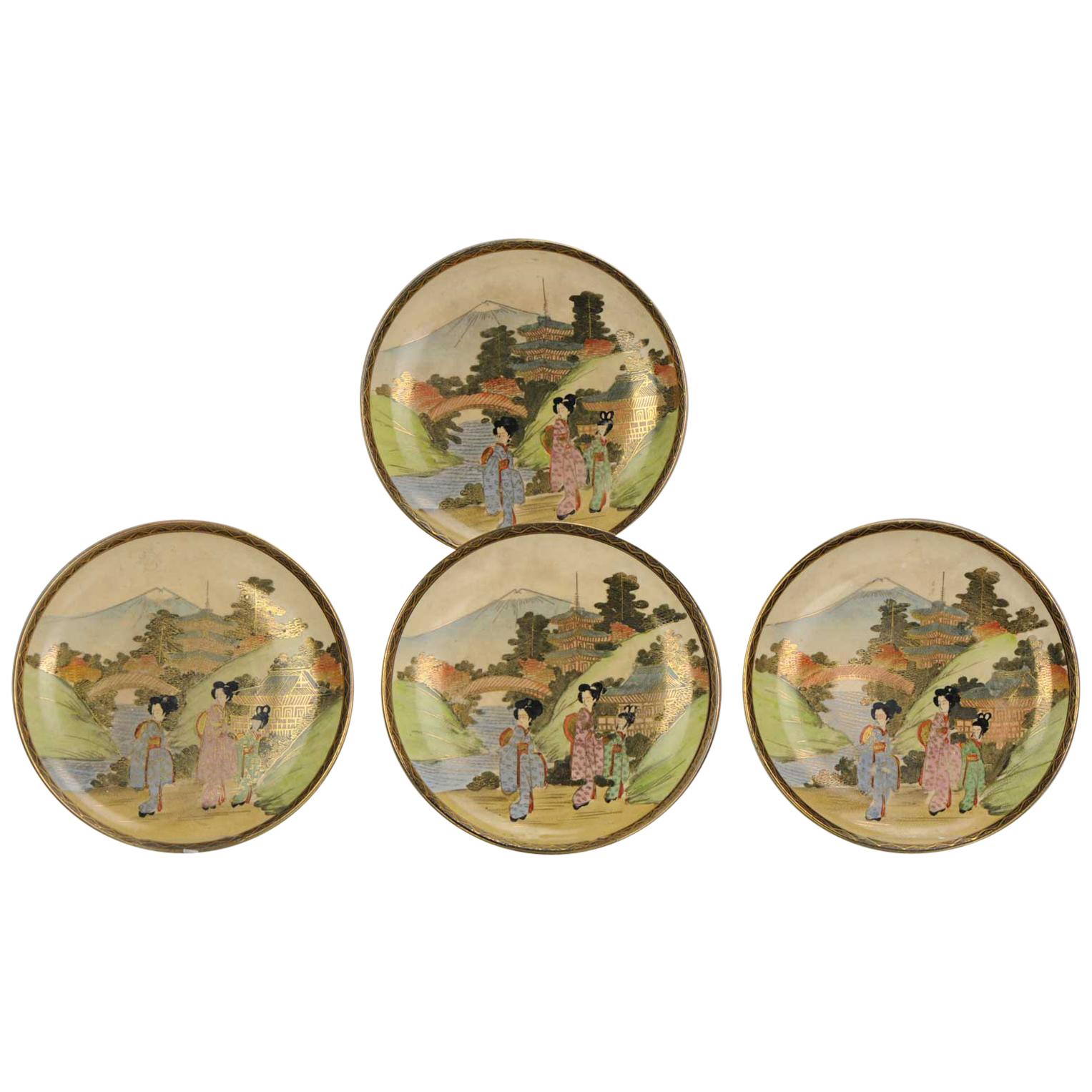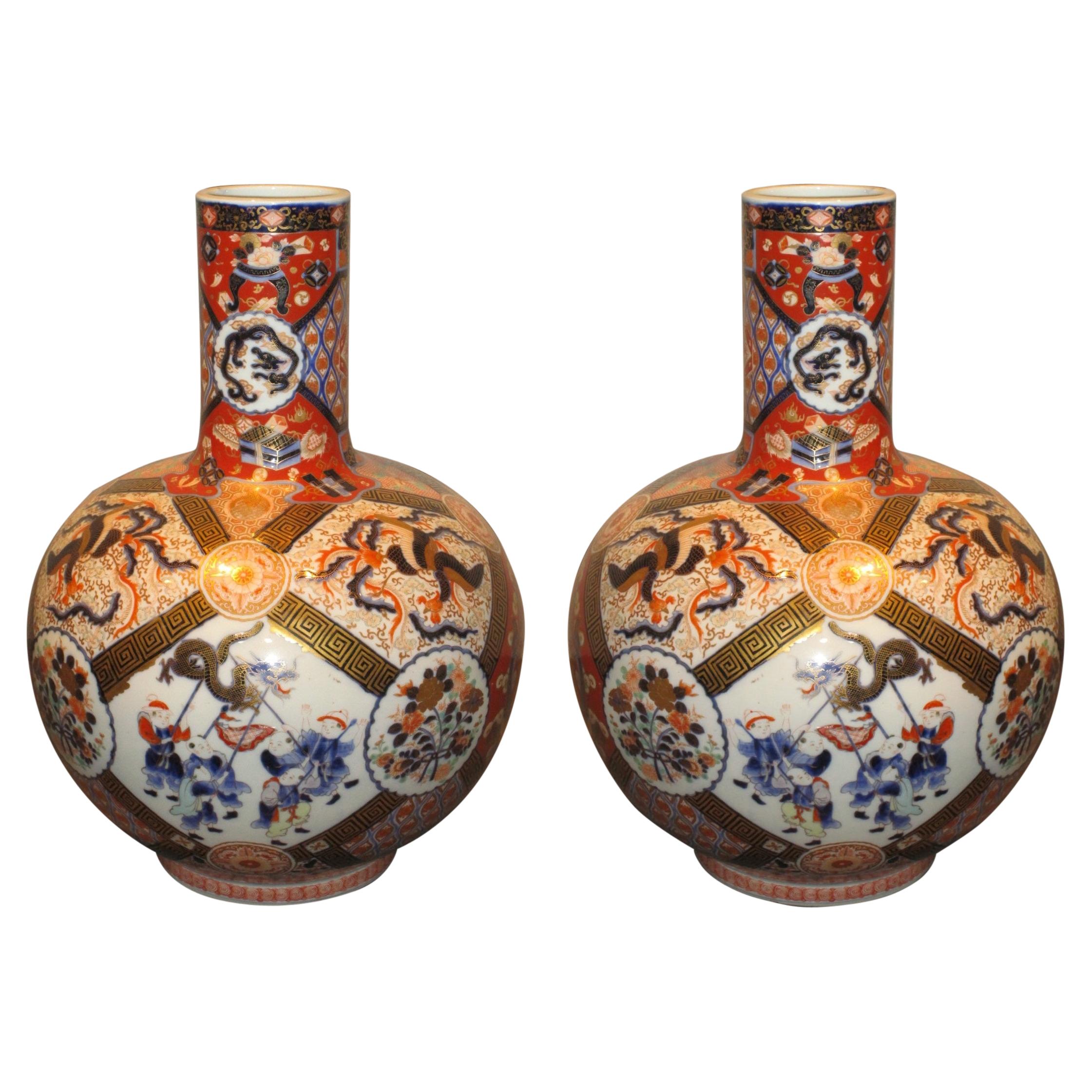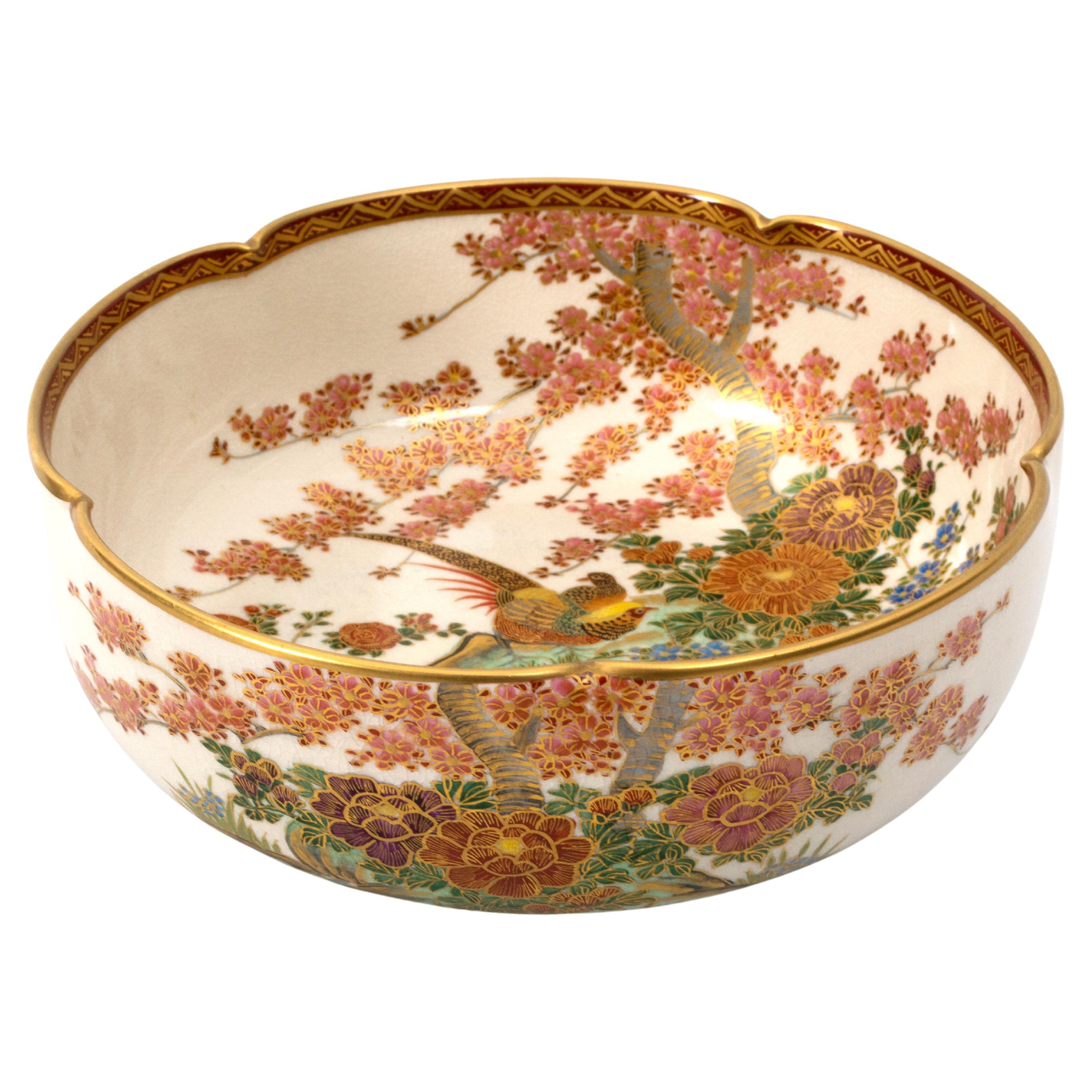Items Similar to Ito Tozan I "Basket and Frog" Ceramic Vessel, Meiji Period, circa 1900, Japan
Want more images or videos?
Request additional images or videos from the seller
1 of 11
Ito Tozan I "Basket and Frog" Ceramic Vessel, Meiji Period, circa 1900, Japan
About the Item
A large and whimsical glazed stoneware "Basket and Frog" vessel or basin by Ito Tozan I (1846 - 1920), Meiji Period, circa 1900, Japan. Impressed maker's mark to the underside reading "Tozan" in seal script.
The delightful vessel formed as a slightly misshapen and loosely woven fishing basket with a series of three woven lug handles. A single green frog decorates the side. The frog with an intense look upon its face, limbs tensed as if about to leap.
Possibly intended as a vessel for flower arranging, the vessel is glazed all over in an attractive yellowish brown ochre with black highlights, darkening to a deeper brown at the rim. This vessel displays a master potter's deep understanding of form and function, material and technique.
Interestingly, there are small areas of overglaze and infilling to the vessel, including one length to the interior, and a few spots to the underside. These "fixes" were almost certainly done by the artist shortly after firing. The spots to the underside seem to correspond to spur marks.
The underside also with an impressed mark of the artist in seal script within an unglazed cartouche. The seal reads "Tozan" for Ito Tozan I.
Ito Tozan I (1846 - 1920) was an important Japanese potter working out of Kyoto during the Meiji Period into the early Taisho Period. He was nationally and internationally recognized during his lifetime, eventually rising to the status of Imperial Household Artist in 1917. He was succeeded by his adopted son, Ito Tozan II (18671 - 1937).
- Creator:Ito Tozan I (Artist)
- Dimensions:Height: 5.5 in (13.97 cm)Width: 15 in (38.1 cm)Depth: 13 in (33.02 cm)
- Style:Taisho (Of the Period)
- Materials and Techniques:
- Place of Origin:
- Period:1900-1909
- Date of Manufacture:circa 1900
- Condition:Repaired: A few areas of infilling to the interior and underside. The infilling almost certainly done by the artist. Wear consistent with age and use. A few areas of infilling and overglaze to the interior and underside. The infilling and overglaze almost certainly done by the artist.
- Seller Location:Austin, TX
- Reference Number:1stDibs: LU894738244572
About the Seller
5.0
Gold Seller
These expertly vetted sellers are highly rated and consistently exceed customer expectations.
Established in 2001
1stDibs seller since 2010
305 sales on 1stDibs
Typical response time: 1 hour
- ShippingRetrieving quote...Ships From: Austin, TX
- Return PolicyA return for this item may be initiated within 7 days of delivery.
More From This SellerView All
- Miyanaga Tozan III Seihakuji Glazed Tokkuri, Showa Era, JapanLocated in Austin, TXA sublime and elegant seihakuji (qingbai or celadon) glazed porcelain tokkuri (sake bottle) by Miyanaga Tozan III, also known as Miyanaga Rikichi, (b. 1935), Showa Period, circa 1980...Category
Vintage 1980s Japanese Showa Ceramics
MaterialsPorcelain
- Japanese Imari Charger, Meiji Period, Late 19th CenturyLocated in Austin, TXA nicely decorated Japanese Meiji Period Imari charger, late 19th century, Japan. The porcelain charger featuring a design of a hoho bird, or phoenix, per...Category
Antique Late 19th Century Japanese Meiji Platters and Serveware
MaterialsEnamel
- Japanese Satsuma Incense Burner, Koro, Meiji Period, Late 19th Century, JapanLocated in Austin, TXA fine and elegant Japanese Satsuma tripod incense burner, koro, with pierced metal lid, signed Eizan (?) Meiji Period, late 19th century, Japan. The koro, or censer, features a stoneware body of slightly compressed globular form, supported on three short and squat legs. The wide mouth with a recessed metal rim, and topped by an openwork metal lid topped with overlapping chrysanthemum blossoms of silver repousse. The body of the koro finely painted with fan shaped cartouches. The fans in the foreground with sprays of blossoming chrysanthemum. The fans in the background with intricate geometric brocade designs. The shoulder of the incense burner decorated with cartouches formed as stylized chrysanthemum petals, and intricately decorated with geometric and floral brocade designs. The painting finely done in raised gilt and polychrome enamels, including the highly desirable gosu blue...Category
Antique Late 19th Century Japanese Meiji Ceramics
MaterialsMetal, Silver
- Large Japanese Imari Gilt Charger, the Six Immortal Poets, Meiji Period, JapanLocated in Austin, TXA bold and unusual large 18.5" diameter Japanese gilt ground Imari porcelain charger featuring the Rokkasen, the Six Immortal Poets, Meiji Period, circa 1900, Japan. The impressive charger features a striking image of the Six Immortal Poets, known as the Rakkasen, seated in fenced pavilion within a lush garden setting and surrounded by numerous books and scrolls. Gnarled pine trees and and branches laden with plum blossoms tower overhead, while chrysanthemum and massive peonies bloom among rocky outcrops. The scene is unexpectedly and masterfully executed as if on a byobu, a traditional Japanese six panel folding screen. The screen is opened in a dramatic manner, slightly akimbo, almost jumping off the dish, reminiscent of the "screens within screens" genre that developed during the Edo Period. Despite the folds and changes in perspective, the painting remains harmonious and lyrical, with the fully gilt ground adding a sense of warmth and sumptuousness. The screen is bordered with a geometric bands in the shippo pattern. The shippo pattern features interlocking circles, and symbolizes the Seven Treasures. The shippo pattern on a larger scale serves at the background fo the rest of the charger. The backside of the charger decorated with two bands with underglaze blue designs. The reserve decorated with scattered stylized blossoms in iron red and gilt. The Rakkasen, known in English as the Six Immortal Poets, are a group of 9th century Heian Period waka poets whose works were included and praised by name in an anthology of poetry collected by the courtier, poet, and writer, Ki no Tsurayuki. Waka poems are a strict five line...Category
Antique Early 1900s Japanese Meiji Ceramics
MaterialsPorcelain
- Japanese Satsuma Tripod Censer, Koro, Meiji period, Early 20th Century, JapanLocated in Austin, TXA small and finely decorated Japanese Satsuma tripod incense burner (koro), signed Kyozan, Meiji period, circa 1900, Japan. The censer, koro, with a compressed body supported by t...Category
Antique Early 1900s Japanese Meiji Ceramics
MaterialsStoneware
- Large Japanese Imari Charger, Edo/Meiji Period, mid 19th century, JapanLocated in Austin, TXA large 18.25" diameter Japanese Imari porcelain charger, Edo to Meiji Period, mid 19th century, Japan. The large charger of near flattened form and decorated in the typical Imari palette of underglaze blue with red, orange and green overglaze enamels and gilt highlights. The design is centered on a roundel with a dense design of scrolling peony blossoms and leaves in underglaze blue. Two large pictorial reserves of Shinto priests...Category
Antique Mid-19th Century Japanese Meiji Ceramics
MaterialsPorcelain
You May Also Like
- Japanese Ceramic Vase by Ito Tozan I Meiji PeriodBy Ito Tozan ILocated in Atlanta, GAThis stoneware vase of a jar form was finely decorated with low relief carving and delicate colored glazes depicting bundles of peony flowers. It was made by Ito Tozan I (1846-1920) circa 1890-1900s in the late Meiji Period. The color pallet was both bold and subtle, with dark green and rusty leaves with golden outlines and white and light yellow peony petals covering much of the surface. Impressed with potter's mark on the base. Examples of two pieces by Ito Tozan I were in the collection of MNAAG (Guimet) Paris. Inventory no. MG 13790 an 13792. A vase with similar shape and decoration techniques is featured as Lot 1340 Fine Japanese Art, 13 Sep 2017 Bonhams New York Tozan Ito I established his ceramic business in Kyoto 1867. His studio made both porcelain and stoneware in a style some considered Satsuma while they retained a sophistication of Kyoto ware...Category
Antique 1890s Japanese Japonisme Ceramics
MaterialsCeramic
- Japanese Mishima Ceramic Vase Meiji PeriodLocated in Atlanta, GAA Japanese long neck slender ceramic vase in the style of Mishima, circa 19th century, Meiji period. Mishima pottery was originally imported from three islands in Taiwan and then fro...Category
Antique 19th Century Japanese Japonisme Ceramics
MaterialsCeramic
- Kutani porcelain cat, Japan, c. 1900, Meiji Period.By Kutani StudioLocated in Gargrave, North YorkshireKutani porcelain okimono of a cat, c. 1900. Meiji Period. £490.00 Kutani porcelain okimono, Japan, c. 1900. Meiji Period. Finely modelled as a sleeping cat, its hair delineated in g...Category
Antique 1890s Japanese Meiji Ceramics
MaterialsPorcelain
- Plates, Satsuma, Meiji Period Mount Fuji Geishas, Japan, circa 1900Located in Amsterdam, Noord HollandNice quality hand painted Satsuma plates. Also marked at base. Condition / Overall condition: Perfect. Size 184 x 30 mm approx. Period 19th century Meiji Periode (1867-1912).Category
Antique 19th Century Japanese Meiji Ceramics
MaterialsEarthenware
- Pair of Japanese Late Meiji Period Fukagawa Porcelain Vases, circa 1900Located in Takarazuka, JPSuperb pair of Japanese large Meiji period Fukagawa signed porcelain vases (circa 1900). Intricately hand-painted in cobalt blue underglaze with polychrome and gold overglaze on a st...Category
Antique Early 1900s Japanese Meiji Vases
MaterialsGold
- Antique Japanese Lobed Satsuma Bowl Meiji Period C.1900Located in London, GBAntique Japanese Lobed Satsuma Bowl Meiji Period C.1900 A Kobe Japan Satsuma bowl, of lobed pedestal form hand painted inside and out. A hand-painted natu...Category
Early 20th Century Japanese Ceramics
MaterialsEarthenware
Recently Viewed
View AllMore Ways To Browse
Asian Green Glaze Pottery
Joseon Dynasty Furniture
Japanese Satsuma Box
Joseon Dynasty Pottery
Asian Very Thin Porcelain Bowls
Imperial Nippon Hand Painted Vase
Antique Chinese Cloisonne Sold
Celadon Bird Motif
Chinese Porcelain Blanc De Chine Goddess Guanyin
Wucai Bowl
Wucai Jar
Xuande Chinese Antique Vase Vases
Antique Gaiwan
Aubergine Clouds Japanese
Benjarong Porcelain
Black Antique Asian Ginger Jar
Ceramic Samovar
Ceramic Warrior Chinese Roof Tile





